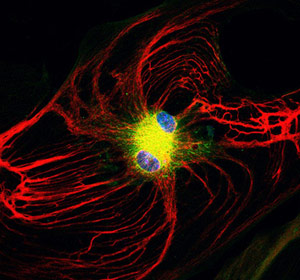
An astrocyte. Credit: UC Davis Health System
A newly published stem cell study from UC Davis uncovers the brain-protective powers of astrocytes, finding that astrocytes can protect brain tissue and reduce disability due to stroke and other ischemic brain disorders.
Sacramento, California – One of regenerative medicine’s greatest goals is to develop new treatments for stroke. So far, stem cell research for the disease has focused on developing therapeutic neurons — the primary movers of electrical impulses in the brain — to repair tissue damaged when oxygen to the brain is limited by a blood clot or break in a vessel. New UC Davis research, however, shows that other cells may be better suited for the task.
Published today in the journal Nature Communications, the large, collaborative study found that astrocytes — neural cells that transport key nutrients and form the blood-brain barrier — can protect brain tissue and reduce disability due to stroke and other ischemic brain disorders.
“Astrocytes are often considered just ‘housekeeping’ cells because of their supportive roles to neurons, but they’re actually much more sophisticated,” said Wenbin Deng, associate professor of biochemistry and molecular medicine at UC Davis and senior author of the study. “They are critical to several brain functions and are believed to protect neurons from injury and death. They are not excitable cells like neurons and are easier to harness. We wanted to explore their potential in treating neurological disorders, beginning with stroke.”
Deng added that the therapeutic potential of astrocytes has not been investigated in this context, since making them at the purity levels necessary for stem cell therapies is challenging. In addition, the specific types of astrocytes linked with protecting and repairing brain injuries were not well understood.
The team began by using a transcription factor (a protein that turns on genes) known as Olig2 to differentiate human embryonic stem cells into astrocytes. This approach generated a previously undiscovered type of astrocyte called Olig2PC-Astros. More importantly, it produced those astrocytes at almost 100 percent purity.
The researchers then compared the effects of Olig2PC-Astros, another type of astrocyte called NPC-Astros, and no treatment whatsoever on three groups of rats with ischemic brain injuries. The rats transplanted with Olig2PC-Astros experienced superior neuroprotection together with higher levels of brain-derived neurotrophic factor (BDNF), a protein associated with nerve growth and survival. The rats transplanted with NPC-Astros or that received no treatment showed much higher levels of neuronal loss.
To determine whether the astrocytes impacted behavior, the researchers used a water maze to measure the rats’ learning and memory. In the maze, the rats were required to use memory rather than vision to reach a destination. When tested 14 days after transplantation, the rats receiving Olig2PC-Astros navigated the maze in significantly less time than the rats that received NPC-Astros or no treatment.
The investigators used cell culture experiments to determine whether the astrocytes could protect neurons from oxidative stress, which plays a significant role in brain injury following stroke. They exposed neurons co-cultured with both types of astrocytes to hydrogen peroxide to replicate oxidative stress. They found that, while both types of astrocytes provided protection, the Olig2PC-Astros had greater antioxidant effects. Further investigation showed that the Olig2PC-Astros had higher levels of the protein Nrf2, which increased antioxidant activity in the mouse neurons.
“We were surprised and delighted to find that the Olig2PC-Astros protected neurons from oxidative stress in addition to rebuilding the neural circuits that improved learning and memory,” said Deng.
The investigators also investigated the genetic qualities of the newly identified astrocytes. Global microarray studies showed they were genetically similar to the standard NPC-Astros. The Olig2PC-Astros, however, expressed more genes (such as BDNF and vasoactive endothelial growth factor, or VEGF) associated with neuroprotection. Many of these genes help regulate the formation and function of synapses, which carry signals between neurons.
Additional experiments showed that both the Olig2PC-Astros and NPC-Astros accelerated synapse development in mouse neurons. The Olig2PC-Astros, however, had significantly greater protective effects over the NPC-Astros.
In addition to being therapeutically helpful, the Olig2PC-Astros showed no tumor formation, remained in brain areas where they were transplanted and did not differentiate into other cell types, such as neurons.
“Dr. Deng’s team has shown that this new method for deriving astrocytes from embryonic stem cells creates a cell population that is more pure and functionally superior to the standard method for astrocyte derivation,” said Jan Nolta, director of the UC Davis Institute for Regenerative Cures. “The functional improvement seen in the brain injury models is impressive, as are the higher levels of BDNF. I will be excited to see this work extended to other brain disease models such as Huntington’s disease and others, where it is known that BDNF has a positive effect.”
Deng added that the results could lead to stem cell treatments for many neurodegenerative diseases.
“By creating a highly purified population of astrocytes and showing both their therapeutic benefits and safety, we open up the possibility of using these cells to restore brain function for conditions such as Alzheimer’s disease, epilepsy, traumatic brain disorder, cerebral palsy and spinal cord injury,” said Deng.
Peng Jiang of UC Davis and Shriners Hospitals for Children was the study lead author. Deng and Jiang’s co-authors were Chen Chen, Olga Chechneva, Seung-Hyuk Chung, and David Pleasure of UC Davis and Shriners Hospitals for Children; Quanguang Zhang and Ruimin Wang of the Medical College of Georgia; Mahendra Rao of the National Institutes of Health (NIH) Center for Regenerative Medicine; and Ying Liu of the University of Texas Health Science Center.
This research was funded in part by the NIH (grants R01NS061983, R01ES015988 and R01NS025044), National Multiple Sclerosis Society, Shriners Hospitals for Children, California Institute for Regenerative Medicine, Memorial Hermann Foundation (Staman Ogilvie Fund) and the Bentsen Stroke Center.
Reference: “hESC-derived Olig2+ progenitors generate a subtype of astroglia with protective effects against ischaemic brain injury” by Peng Jiang, Chen Chen, Ruimin Wang, Olga V. Chechneva, Seung-Hyuk Chung, Mahendra S. Rao, David E. Pleasure, Ying Liu, Quanguang Zhang and Wenbin Deng, 23 July 2013, Nature Communications.
DOI: 10.1038/ncomms3196

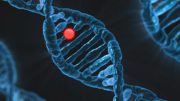
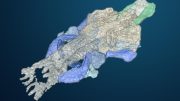

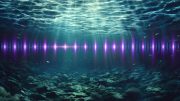

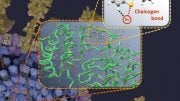
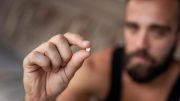
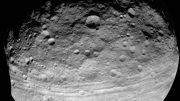
Be the first to comment on "Stem Cell Study Reveals the Brain-Protective Powers of Astrocytes"